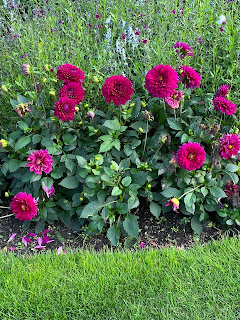The terribly early death of Hilary Mantel at 70 robs the British cultural scene of a huge shining light perhaps at the zenith of her formidable powers. Born in Derbyshire and brought up as a Roman
Catholic, Mantel had lost her father by the age of 11, and her faith by the age of 12; she discussed her religious views in her 2003 memoir, Giving Up The Ghost, claiming religion had left a permanent mark on her....the real cliché, the sense of guilt. You grow up believing you are wrong and bad. And for me, because I took what I was told really seriously, it bred a very intense habit of introspection and self-examination and a terrible severity with myself. So that nothing was ever good enough. It’s like installing a policeman, and one moreover, who keeps changing the law. “
In a 2013 interview with The Telegraph, Mantel said, “I think that nowadays the Catholic Church is not an institution for respectable people. ….. When I was a child, I wondered why priests and nuns were not nicer people. I thought that they were amongst the worst people I knew.”
 |
| Hilary at 9 |
Mantel also partly attributed to the early onslaught from religion, her preoccupation with unseen reality; she never questioned the existence of ‘the next world’. When she was tiny, she lived with her grandmother whose sister lived next-door and whose nephew lived nearby in his deceased parents’ house and every day her grandmother and sister would sit by the fire like bookends, and gossip about the living and the dead with no distinction made between the two. The small Hilary listened and absorbed. “So, although I knew Martin and Harriet were dead, I felt as if they were barely dead.” "Since I was a very small child, I've had a kind of reverence for the past and I felt a very intimate connection with it."
 |
| Gerald MacEwen with Hilary |
 |
| A younger Thomas Cromwell |
 |
| Anne Boleyn. Used flirtation, faith and fertility to catch the King |
In her first two Wolf Hall books, Mantel invents a Cromwell who is courteous, even tender at times, rather belying his early brutal life as a street urchin with a violent father. He is usually logical, rational, but doing his best to serve an irrational, narcissistic, regal ego. He wants to live, after all. However, in the first two sentences of The Mirror and The Light, Mantel has Cromwell walking away from the decapitation of Anne Boleyn and wondering idly about a second breakfast. He is hugely powerful, having engineered Anne’s death, watched the head fall and the blood flow, but he is also so supremely confident and bien dans sa peau, to consider the treat for himself of a second breakfast as he leaves the execution site. Mantel thus sets the scene for his final chapter and the third book, demonstrating her skill in two lines!
Her preoccupation with death and the next world appears in others of Mantel’s book. For instance, in The Giant, O’Brien, Mantel explores and contrasts the lives of two real-life 18th century figures, a freakishly tall Irish sideshow performer, O'Brien, and a Scottish scientist, Dr. Hunter, who is preoccupied with what happens at the moment of death; he is frustrated because he doesn’t know where the dead have gone nor how he can get them back. He was interested in resuscitation after apparent death and in suicides who sought death in the Thames.
 |
| Thomas Cromwell, all powerful statesman. |
“There are not many writers who, like prophets, seize, melt down and reshape the archetypal stories of their people.” [ MacFarquhar. Sept 24, 2022. New Yorker.]
 |
| After receiving an honorary degree from University College, Dublin. 2016. |
AWARDS
1987 The Shiva Naipaul Memorial Prize for an article on Jeddah.
1989 The Winifred Holtby Memorial Prize for Fludd.
1989 The Cheltenham Prize for Fludd.
1989 The Southern Arts Literature Prize for Fludd.
1992 The Sunday Express Book of The Year for A Place of Greater Safety.
1994 The Sunday Express Book of The Year for A Change of Climate.
1995 The Sunday Express Book of The Year for An Experiment in Love.
1996 The Hawthornden Prize for The Giant, O’Brien.
2006 Short-listed for Commonwealth Writers’ Prize for Beyond Black.
2009 The Man Booker Prize for Fiction for Wolf Hall.
2009 Short-listed for the 2009 Costa Novel Award for Wolf Hall.
2010 The Inaugural Walter Scott Prize for historical fiction for Wolf Hall.
2010 Short-listed for the Orange Prize for Fiction for Wolf Hall
2012 Man Booker Prize for Fiction for Bring Up The Bodies.
2020 Short-listed for the Man Booker Prize for Fiction for The Mirror and The Light.
2021 The Walter Scott Prize for The Mirror and The Light.
REWARDS
2006 Awarded a C.B.E.
2013 Wolf Hall and Bring Up The Bodies were both adapted for the stage and performed
by the Royal Shakespeare Company in the Swan Theatre, Stratford-on-Avon.
2014 Both plays transferred to the Aldwych in the West End after which they moved to Broadway.
2014 Awarded a D.B.E. becoming Dame Hilary.
2015 Wolf Hall and Bring Up The Bodies, adapted into a six-part mini-series on BBC 2.




















.jpg)













